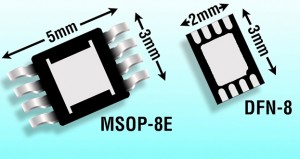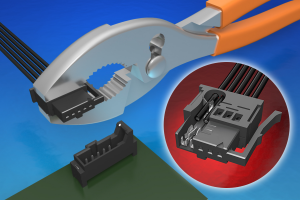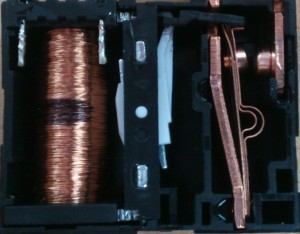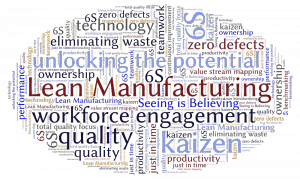FAIRFIELD, CT—Scientists at GE are experimenting with a technology, called Direct Write, that uses special “inks” to print miniature sensors directly inside jet engines, gas turbines and other hot, harsh and hard-to-reach places.
Raytheon, UMass to Establish Research Institute
LOWELL, MA—Raytheon Co. and the University of Massachusetts Lowell will establish a $3 million joint research facility here dedicated to future technologies for radar and communication systems.
Regulator drives 200mA but drops only 300mV
 Linear Technology’s latest low dropout voltage linear regulator is capable of delivering up to 200mA continuous output current with a 300mV dropout voltage at full load.
Linear Technology’s latest low dropout voltage linear regulator is capable of delivering up to 200mA continuous output current with a 300mV dropout voltage at full load.
The input voltage range is 1.6V to 45V and the output voltage is adjustable from 0.6V to 40V.
The LT3062’s output voltage tolerance is specified at ±2% over line, load and temperature. The device’s wide input and output voltage ranges, fast transient response, low quiescent current of 40µA (operating) and <1µA (in shutdown) make it ideal for portable battery-powered systems that require optimum run time, and for automotive, industrial and avionic power supply applications.
A single capacitor provides both programmable ultralow noise operation – only 30µVRMS across a 10Hz to 100kHz bandwidth – and reference soft-start functionality, preventing output voltage overshoot at turn-on.
There is internal protection circuitry includes reverse-battery protection, reverse-output protection, reverse-current protection, current limit with foldback and thermal limiting.
The LT3062 is offered in thermally enhanced 8-lead 2mm x 3mm DFN and MSOP packages.
Raspberry Pi software guru to answer your questions
Raspberry Pi’s head of software will be answering designers questions about the embedded computing platform.
Gordon Hollingworth will answer designers’ questions put to him by Matt Timmons-Brown, the Raspberry Pi Guy, in an online interview and the Raspberry Pi foundation is inviting questions from designers.
See George Hollingworth’s previous online interview, posted in February.
What about the hardware?
See also: Raspberry Pi is changing
The embedded computing module will see one of its largest changes in format and design next month. Eben Upton, founder of the Raspberry Pi Foundation Raspberry Pi, discusses the reasons for the design changes in the new Raspberry Pi Compute Module.
UK benefits from stronger chip sales through distribution
Semiconductor sales through distribution channels in Europe grew by 5.3% to €1.6bn in the second quarter to the end of June, according to DMASS (Distributors’ and Manufacturers’ Association of Semiconductor Specialists).
The UK semiconductor distribution market grew by 7.3% to €131m.
Only Germany and Eastern Europe grew faster than the UK with 11% and 10.2% respectively. Q2 sales in German were €514m.
“Our market seems to have reached a solid growth level in the 5% plus range. Particularly encouraging was the fact that Germany, after a few weak quarters, is back on track and brought in a very healthy 11% increase over CY13,” said Georg Steinberger, chairman of DMASS.
The wider trend is also positive with the first six months of the year 6.6% up on the first half in 2013.
Except for France, Benelux, Nordic and Switzerland, all the major markets grew.
France saw sales slip by 2.6% to €122m, while distribution sales in the Nordic region were down 8.7% in Q2.
Steinberger: “Nordic and Benelux were certainly the weak spots last quarter while Germany regained some of its old strength. Over the course of 6 months, the picture has stabilised somewhat, but some risks remain: France develops below average, Benelux, too, and we do not know yet the impact of the sanctions against Russia in our market, although Russia only contributes 4% to the DMASS Total.”
Component categories with the healthiest growth were LEDs/optoelectronics (13.5%) and discrete components (13.6%).
ARM sponsors Science Museum comms gallery
 ARM is sponsoring Information Age a new gallery to be opened at the Science Museum on 25 October.
ARM is sponsoring Information Age a new gallery to be opened at the Science Museum on 25 October.
Using interactive displays and experiences, the gallery will reveal personal stories about how life has been transformed by communication innovations over the last two centuries.
Information Age will be divided into six zones, each representing a different information and communication technology network; The Cable, The Telephone Exchange, Broadcast, The Constellation, The Cell and The Web.
The gallery will explore the important events which shaped the development of these networks, from the dramatic stories behind the growth of the worldwide telegraph network in the 19th century, to the influence of mobile phones on our lives today.
Re-live remarkable moments in history, told through the eyes of those who invented, operated or were affected by the new wave of technology, from the first BBC radio broadcast in 1922 to the dawn of digital TV.
Discover how wireless technology enabled lives to be saved and news of the Titanic disaster to be spread to the world within hours of the event, and hear the personal stories of the operators who worked on the Enfield Telephone Exchange, the last manual exchange which marked the end of an era in communication history.
IDC wire termination gets tough
 Samtec has introduced a 2.00 mm pitch discrete wire IDC system designed to simplify and strengthen discrete wire termination in field applications.
Samtec has introduced a 2.00 mm pitch discrete wire IDC system designed to simplify and strengthen discrete wire termination in field applications.
The discrete wire IDC system includes a cable socket, our I2SS Series, and a mating board level header, our T2I Series.
The cable component is available in 2, 3, 4 or 5 positions and accepts 24 AWG discrete wire cables, which are held in place by the contacts and then terminated with standard flat jaw pliers.
The board level connector is a single row configuration with through-hole termination for increased stability on the board. In addition, a single end latching system is standard for secure locking. The shrouded and polarised system is RoHS compliant and lead-free solderable.
This system will bring the benefits of assembly without special tooling to field applications such as installation, testing and maintenance.
Manufacturer buys M2M firm to target IoT business

(L-R): Tony McFadden, Director at United, Charlie Peppiatt, CEO Stadium, Joanne Estell Finance Director, Stadium and Craig Helm, Director at United
Stadium Group has acquired a manufacturer which specialises in M2M wireless devices for use over cellular networks.
The Cheshire-based company, United Wireless operates in the automotive and telematics sectors. It employs 40 people.
Stadium said it has a strategy to add complementary products, design capability and global supply chain management.
Stadium already provdies PCB assembly and box build, power supplies, battery chargers and back‐up supplies, intelligent interface and display systems.
M2M is seen as a high growth market by the UK-based manufacturer.
“Global demand for M2M wireless devices is forecast to expand at a 24% compound annual growth rate over the next 5 years, with the number of cellular M2M device subscribers to rise to 490 million by 2018. This acquisition adds a new dimension to our product portfolio, complements our existing group companies and will allow us to engage with the rapid development of the Internet of Things,” said Charlie Peppiatt, CEO of Stadium.
“Our strategy will be achieved by expanding our offering in products and technologies that complement the existing iEMS, Power Products and Interface & Displays businesses, offering ‘adjacent products’ to widen the business opportunity with each individual customer. A key fourth cornerstone to this strategy has been a focus to expand into the M2M wireless devices space where there is a huge growth potential.”
United will trade under the new name of Stadium United Wireless.
Does off really mean off in a smart meter?
 Reduction in energy use is high on the agenda of customers, who have to pay for wasted energy, utilities which need to keep pace with growing energy consumption, and of governments, who have to handle the macro-effects of global warning.
Reduction in energy use is high on the agenda of customers, who have to pay for wasted energy, utilities which need to keep pace with growing energy consumption, and of governments, who have to handle the macro-effects of global warning.
Whether the need is to effectively control new lighting technologies, to fully power down systems on standby, or to protect smart meters against illegal tampering, relays and switches are playing a central role in making the next generation of electronic and electrical systems energy efficient and make a real contribution to the overall reduction of energy use.
Switch and relay manufacturers are responding to these needs. For example, new latching relays are designed to help save energy in lighting control systems. New switches can be remotely controlled, allowing a system to be fully isolated automatically if required. Tamper proof switches, DC power relays and other designs are also coming on the market to support the new wave of eco-friendly electronics and energy saving systems.
Latching relays
Lighting technologies such as fluorescent and LED lamps are much more efficient, but energy can still be wasted if they are not switched off when the room is unoccupied.
Users can’t be relied on to do this, and automatic control systems are becoming commonplace and sometimes even mandatory. These systems rely on a switch or relay to actually effect the switching, but these have to cope with the high inrush currents associated with the starter capacitors in fluorescent lights and LED driver circuits.
Latching relays that are only energised while switching and use less power than non-latching designs are by far the best and most efficient approach. Two new energy saving latching relays from Omron feature the capacity to handle these high inrush currents.
Latching relays are also central to smart meter design, to implement the remote disconnect function required for load management, time of day (ToD) tariff-switching, disconnect and pre-payment. To achieve low overall meter power consumption a bi-stable latching relay design with the highest electrical performance is desirable. This is a very specialist application, with very specific requirements. Considerations include small overall size to minimise the size of the meter and resistance to tampering using an external magnet.
Latching relays are also suitable for movement control, smart meter, power line switching and sub metering applications.
Remote reset switches
One of the key goals of the Eco-Design Directive is to limit, and eventually eliminate, standby power. Electromechanical switches can completely power down a system, but until now a limitation has been that they need to be manually actuated.
Remote reset switches provide a great solution, drawing no power until they are activated and therefore are helpful in implementing systems that eliminate standby power and meet the European Commission ErP Ecodesign directive.
Versions of these switches can also address the issue that some systems need to follow a set shut-down sequence to avoid loss of data or circuit damage. For example, capacitors may need to be discharged before a system can be regarded as safely switched off.
To address this, remote reset switches with a delayed off function are available to allow safe shut down of electrical equipment. With such switches, the power to the system is maintained when the switch is returned to the off position. The system is then powered down by an external signal after an interval determined by the designer.
These remote switches are suitable for a range of industrial and consumer electrical applications and even support high inrush currents to TV-8 standards.
Tamper proof switches
Remote reset switches is just one example of the way in which switch design is evolving to address new requirements. For example, an issue with smart meters, industrial control systems and other applications is tamper detection.
A switch is commonly used to detect when the cover of a system has been opened. Smart meter anti-tamper switches may not be actuated for years, but should still operate reliably should the meter be attacked after this period.
Switches for this application, such as the Omron D2FS sub-miniature snap-action switch, are designed to support long term operation even with very low switching frequencies. This switch incorporates a single-leaf movable spring and an edge shaped fixed contact, which exerts a high contact force per square metre and aids wiping movement keeping the contact surface clean.
It is a challenge for electronic designers to ensure that off really does mean off for the systems that they design. The Eco-design directive puts regulatory force behind this need, but truthfully customers are increasingly aware of the cost of energy, and leaving a system powered when not in use can affect its safety and service life too. Human users cannot usually be relied on to turn off equipment when it isn’t required, and some form of automation is required.
Switches and relays are inherently energy efficient as they will fully disconnect a system or sub-system from its power supply, so that it is properly powered down when not in use.
New products designs use less energy in themselves and are easier to actuate through software. These switches and relays can make a real contribution to creating a new generation of systems that are more efficient, cost less, are more reliable, and at the same time meet or exceed the requirements laid down in EU and other directives.
Andries de Bruin is European product marketing manager, Omron Electronic Components Europe.
NMI conference to discuss lean manufacturing
 NMI, the UK’s microelectronics industry association, will hold its annual manufacturing conference at the University of Warwick on October 1st.
NMI, the UK’s microelectronics industry association, will hold its annual manufacturing conference at the University of Warwick on October 1st.
NMI is very keen on the concepts of ‘lean’ manufacturing and the conference programme has four themed sessions:
- Lean 2020: Visions for Lean in the future
- Lean Leadership: The role of the leader in delivering Lean
- Lean in Action: Case examples of successful implementation
- Lean Beyond Production: Case examples of how the principles of LEAN can be applied to other parts of the organisation
A keynote speaker will be Jason Speedy, head of manufacturing for Siemens at its Congleton plant. He will highlight the importance of leadership and staff development.
Places at the conference are free to NMI members and just £125 for non-members.
David Law, Director of Manufacturing Services at NMI said:
“The manufacturing excellence conference has grown each year and just gets better and better. It has become a key event for our manufacturing members where everyone benefits from participating and learning from each other. This is a tangible benefit we see week in, week out through our regular ‘action-orientated’ activities. It is therefore exciting to bring an extended manufacturing community together in this way. We believe that manufacturing has a bright future in the UK when we play to our strengths – a position that is bettered by working together wherever possible. We’re delighted to provide such a forum for that collaboration to happen and invite both members and non-members to the conference.”


